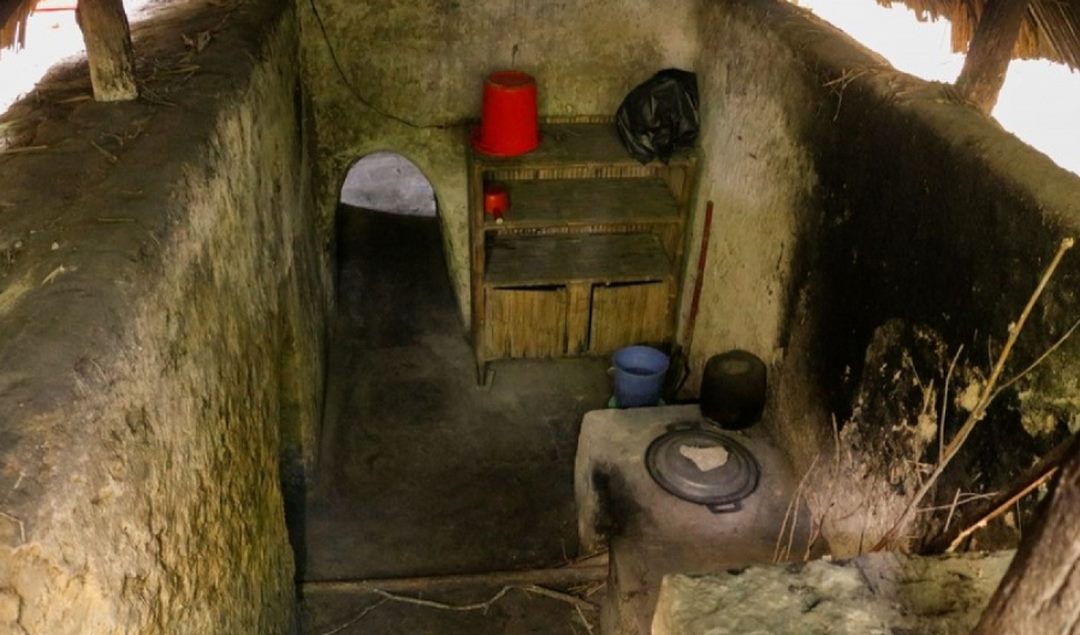The Cu Chi Tunnels traps that struck fear into American soldiers
Cu Chi Tunnels traps were not only a symbol of the creativity and resilience of the Vietnamese people but also a source of unforgettable fear for American soldiers during the war. Ingeniously constructed and hidden underground, this tunnel system confused and hindered the enemy’s approach, while setting the stage for surprise attacks with deadly traps.

The Cu Chi Tunnels Traps: An Ingenious Defense Against American Firepower
The Cu Chi Tunnels are renowned as a “land of steel,” standing firm against the powerful firepower of American forces due to their ingenious design and remarkable resilience. This underground fortification, hidden 3-8 meters below the surface, is skillfully camouflaged within the tropical jungle, creating a secret maze that played a crucial role in the resistance.

The system consists of three floors, with a “backbone” road leading to multiple connecting branches, one of which even reaches the Saigon River. The first floor, just 3 meters underground, is built to withstand heavy artillery and tank fire. The second floor, 5 meters below, is strong enough to resist small bombs, while the third floor, 8-10 meters deep, is considered extremely safe. Secret hatches between floors allow for discreet movement.
The tunnel system, known for its “Cu Chi Tunnels traps,” was more than just a shelter. It includes large resting bunkers, weapons storage, water wells, and Hoang Cam kitchens, creating a fully functional underground living space. Additionally, a large, camouflaged bunker was used for entertainment activities such as movie screenings and performances, helping to boost the soldiers’ morale during the war.

Today, the Cu Chi Tunnels still retain their wartime appearance, with secret hatches and doors, and vents leading to the surface, providing ventilation and communication. Some vents were also used as secret firing points to destroy enemy forces. The system was also protected by many Cu Chi Tunnels traps. These sophisticated traps were carefully camouflaged, making it difficult for enemy troops to approach and infiltrate the tunnels.
The construction of the tunnels was a long, laborious process carried out by multiple generations of Cu Chi residents over 20 years. Each digging team consisted of 3-4 people, with young men handling the digging and women discreetly transporting the soil elsewhere to avoid detection. The people of Cu Chi displayed remarkable ingenuity with their camouflage tactics, even using American clothing and ground pepper to throw off hunting dogs. These efforts transformed the Cu Chi Tunnels into a true “steel land,” a testament to the indomitable spirit and resilience of the Vietnamese people in the face of overwhelming enemy attacks.

The Cu Chi Tunnels traps and their free PTSD
As the Americans attempted to take control of the Cu Chi area with B-52 bombing and heavy artillery fire, they were met with unexpected challenges from the sophisticated tunnel system of the Vietnamese guerrillas. Despite constant attacks, Cu Chi became a dead end for the American forces, forcing them to crawl into dark tunnels in search of their opponents.

Unlike the portrayal in Hollywood movies, the real “tunnel rats” weren’t tall soldiers, but rather small, daring troops, ready to charge into the deadly darkness. Inside the tunnels, they faced cramped spaces, thick darkness, and numerous lethal traps, from landmines and venomous snakes to attacks by highly skilled guerrilla fighters.
This tunnel system wasn’t just a place to hide; it was meticulously designed to attack the enemy from all directions. The zigzagging tunnels connected to form a complex network with many secret branches and cleverly disguised escape routes. The ventilation shafts not only helped the guerrillas survive underground but also doubled as hidden firing points for surprise attacks.

Cu Chi Tunnels traps, though made from simple, crude materials, these traps were highly effective in killing American soldiers. Bamboo spike pits, or “spike pits,” caused numerous casualties. They were expertly camouflaged, often catching soldiers by surprise and inflicting serious injuries when they fell into them.

In addition, other sophisticated traps like the “Chông chồng” and “Công hom” kept American soldiers constantly on edge. The “Chông tho” was a hidden trap beneath leaves, poised to strike the enemy when stepped on, while the “Công hom,” soaked in water, inflicted serious injuries on soldiers just as they landed. These clever designs made it even more challenging for American troops to navigate the area safely.

The Cu Chi Tunnels traps were not only lethal but also created nightmares for American soldiers. Trigger traps and hanging spike traps were typical examples, allowing Vietnamese guerrillas to attack effectively without having to face them head-on. These types of traps, when encountered, could cause immediate casualties.
Conclusion
Cu Chi Tunnels traps not only symbolized the creativity and indomitable spirit of the Vietnamese people during the resistance war but also served as a source of terror for the American army. This intricate system of traps and underground tunnels showcased the guerrillas’ intelligence and highly effective combat strategies. Today, the Cu Chi Tunnels stand as a significant historical site, attracting tourists eager to explore and learn about the unique tactics and extraordinary efforts of the people who built and defended it.

